|
|
Your Details
|
|
Your Details
|
Reviewed By Andreas Zabczyk
Purple and Violet Gemstones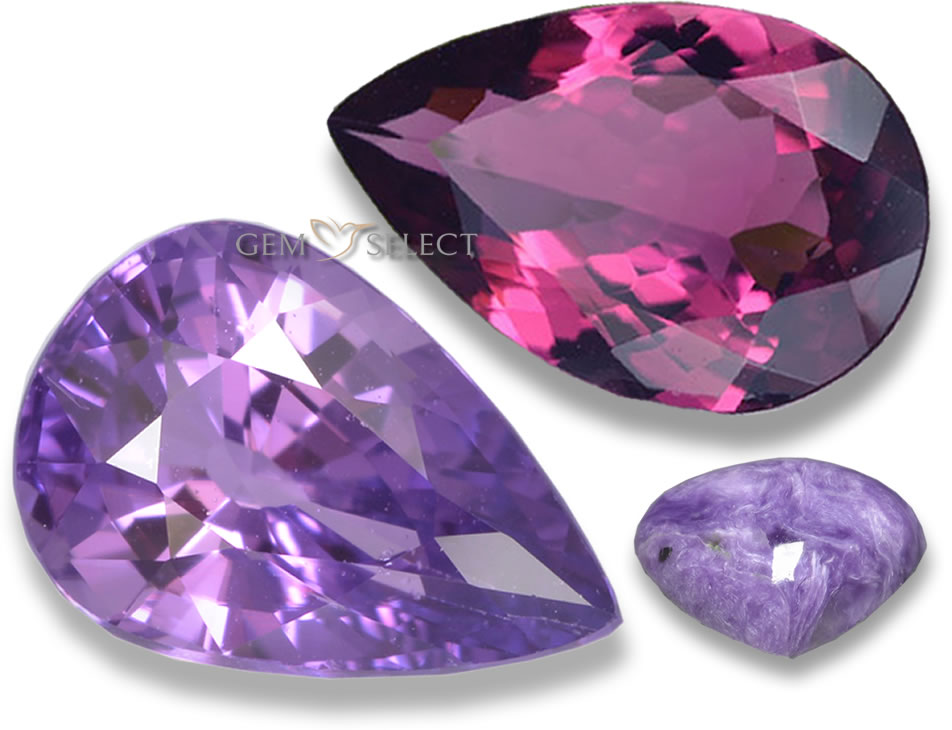 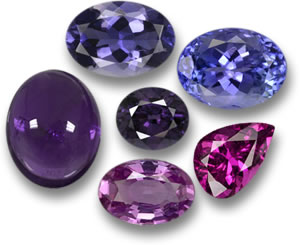 Purple and violet gemstones have long captivated jewelry enthusiasts with their rich hues and vibrant allure. Ranging from the deep, regal tones of amethyst to the enchanting shades of tanzanite, these gemstones evoke a sense of luxury and sophistication. Historically associated with royalty and spirituality, purple stones carry a variety of meanings and symbolism, making them a popular choice for both personal adornment and meaningful gifts. In this article, we will explore the most prominent purple and violet gemstones for jewelry, their unique properties, and how they can elevate any jewelry collection, offering insight into their beauty and significance in the world of fashion and design. Explore our wide selection of violet purple gemstones for sale. The first purple gemstone that usually springs to mind is amethysts, which is a variety of quartz and occurs as geode gems as well as polished stones. Fine amethyst has been mistaken for purple sapphire in the past, in particular, the Delhi Purple Sapphire, which has an interesting story of ill-fate. Yet, this beautiful purple gemstone actually turned out to be a rather large amethyst. Other well-known amethysts include the Duchess of Windsor's amethyst and turquoise necklace designed by Cartier in 1947 and the Kent Amethyst Demi-Parure owned by the Queen of England. While deep purple amethyst is valued above all, it is also available in lighter shades, which are preferred by some gem enthusiasts. This is sometimes referred to as "Rose de France"; a trade name for light colored amethyst that appears somewhat like kunzite. Amethyst is the birthstone for February and is attributed with the ability to prevent intoxication. While amethyst is probably the best-known purple stone, it is not the only one; there are several other options to consider, depending on the requirements. 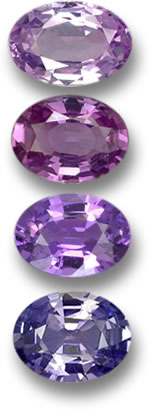 Although blue is the best-known color for sapphire gems, purple sapphires colored by vanadium, iron or titanium traces are quite rare. Purple sapphires vary between pinkish-purple to cool violet. Some purple sapphires have the ability to show a color change under different lighting conditions. Purple sapphires are perfect for engagement rings or other jewelry that will be exposed to daily wear and tear. Sapphire has it all; superior hardness, brilliance, color and durability, but it comes at a high price in large sizes. Spinel gems are available in a stunning array of purple and violet hues, ranging from reddish-purple to cool grayish-violet. These gems not only boast vibrant, pure colors across their spectrum but also exhibit remarkable brilliance and impressive hardness. Additionally, purple and violet gems for jewelry like spinel are often untreated and generally more affordable than rubies and sapphires. While large purple spinel stones can be rare, smaller stones are readily available, and their captivating color and sparkle more than make up for their size. The most famous spinel gemstones are red, rather than purple and some of them have been mistaken for fine ruby. Such historically important spinel gems include the Black Prince's Ruby. Another such stone sits atop the Russian Imperial Crown and weighs 398.72 carats. 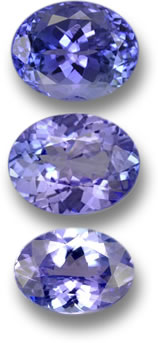 A gemstone with cool violet colors is tanzanite, which is a pleochroic gem that may display blue or violet depending on the angle from which it is viewed. In fact, the most desirable tanzanite color is bright blue, so gemstones tend to be cut to maximize the blue rather than the violet hue. Yet, many stones lean toward the violet end of the scale. Tanzanite is only found in the hills of Northern Tanzania, the country after which it was named by Tiffany & Co. While tanzanite is not as hard as spinel or sapphire, it has incredible color saturation, which is why it is so valued. Indeed, by looking at the magnificent color of tanzanite, it is easy to see why this official December birthstone has become so popular. It is affordable in 1 to 2 carat weights and is best in protected settings for rings that will be worn daily. This is because of its perfect cleavage, which like diamond means that a single blow can cleave it. The most incredible tanzanite gem is the 242-carat "Queen of Kilimanjaro", which is mounted in a white gold, serpent-like tiara with tsavorite garnet and diamond. Another violet gem is iolite, which gets its name from the Greek word for "violet"; "ios". Like tanzanite, iolite is pleochroic. It appears blue or violet when viewed from one direction, colorless from another and yellowish when viewed from a third direction. Iolite gems may be pale to dark-blue or violet, and are translucent to transparent. An important historical use of iolite was as a polarizing filter for Vikings, who navigated by the position of the sun. Like tanzanite, iolite gems have good hardness, but should not be exposed to hard blows due to its cleavage. Therefore, if iolite is to be worn daily in a ring, it should be mounted in a protective setting. A benefit of iolite apart from its wonderful color is that large gems are affordable and great for statement jewelry pieces. 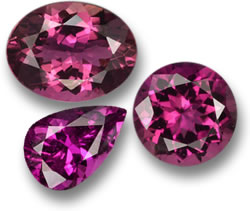 For those who prefer the warm side of purple, tourmaline is a hot choice. Purple tourmaline stones tend to be deep pink or warm purple. These are highly valued gems known as rubellite tourmaline and show fantastic vivid color that will wow any colored stone fan. The most prized rubellite stones appear similar in color to rubies. One such fine red tourmaline was fashioned into in incredible poppy brooch by Joel Arthur Rosenthal. It was owned by Lily Safra and auctioned by Christie's for $1,273,320 in 2012. Rubellite tourmaline is rare, but untreated. It has excellent luster, good hardness and is stunning in any jewelry application. When it comes to opaque, cabochon gems, there is a little less choice. Purple cabochon gems include lavender chalcedony and lavender jadeite, which tend to be less saturated hues, so are not always considered to be true purple gems. More vivid are sugilite and charoite; two gem types that are not widely known by mainstream gemstone dealers. Sugilite is a fairly recent discovery; it was first found in Japan in 1944, but was not suitable for gemstones. However, in 1979, gemstone appropriate sugilite was discovered in South Africa. Sugilite ranges in color, from pale lavender to deep purple or violet. It may be uniform or multicolored with yellowish, brownish-red or black blotches. Sugilite may also have a mixed composition, containing chalcedony or host rock. Stones with patterns are often prized for their uniqueness. Most sugilite is opaque and therefore cut as cabochons, but rare, translucent sugilite has been faceted. Sugilite has been referred to as "sugilite jade" or "purple turquoise", but it is related to neither of these. Sugilite is hard and durable enough for most jewelry applications. 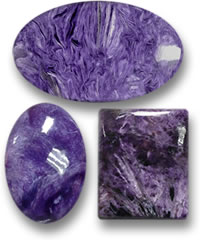 Charoite is another rare purple gem that is a recent find. Like sugilite, it was first discovered in the 1940s, but was not produced commercially until 1978. Also like sugilite, the color of charoite ranges from lavender to deep purple, but differs from sugilite in its appearance. Charoite has a distinctive swirled or streaked pattern, which makes it stand out. The streaks of charoite may be whitish, black, green or orange, making it a multicolored gemstone which is predominantly purple. In addition, charoite possesses some chatoyancy, giving it a translucent marbling effect. It is often described as being "unnaturally beautiful" and treated with suspicion, but charoite is a natural gemstone mined only from Siberia. Since charoite has a sole source, it is said that its supply may soon be depleted. Charoite is not a very hard stone, so it should be protected from wear and tear in jewelry that is worn on a daily basis. Whether a warm purple or cool violet is preferred for gemstone jewelry, both hues are stunning in either yellow or white metal. Of purple, a writer called Uniek Swain said, "All the other colors are just colors, but purple seems to have a soul. Purple is not just a noun and an adjective but also a verb - when you look at it, it's looking back at you." From the ancient use of Tyrian purple to Purple Rain, it certainly is a color that captures the imagination like no other. If you select this color, do not be a shrinking violet, but be a violet vision. Adorn yourself with our violet purple gemstones for sale, and they will radiate elegance and positivity with every wear. |
